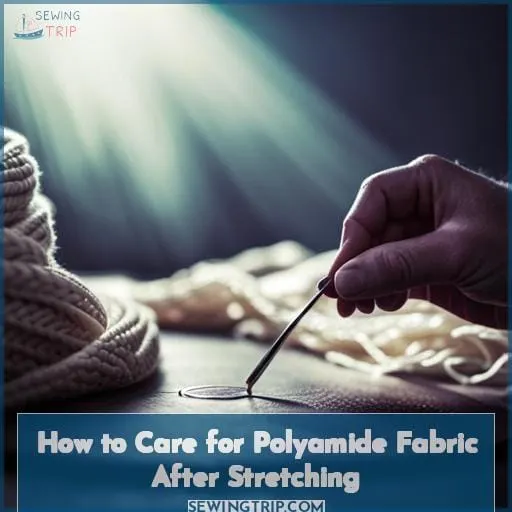This site is supported by our readers. We may earn a commission, at no cost to you, if you purchase through links.
 Imagine slipping into a fabric that effortlessly molds to your body, giving you the freedom to move with ease and grace.
Imagine slipping into a fabric that effortlessly molds to your body, giving you the freedom to move with ease and grace.
Whether you’re a textile engineer, fashion designer, or fabric retailer, understanding the stretchiness of polyamide is crucial in creating garments that empower and liberate wearers.
In this article, we delve into the question: Is polyamide fabric stretchy? Join us as we unravel this mystery and unlock new possibilities for your designs.
Table Of Contents
- Key Takeaways
- Is Polyamide Fabric Stretchy?
- How Does Polyamide Compare to Other Fabrics in Terms of Stretch?
- Does Polyamide Stretch Over Time?
- What Factors Influence the Stretchiness of Polyamide Fabric?
- Can You Stretch Polyamide Fabric?
- How to Care for Polyamide Fabric After Stretching
- Is Polyamide a Breathable Fabric?
- Frequently Asked Questions (FAQs)
- Conclusion
Key Takeaways
- Polyamide fabric is more elastic than cotton.
- Polyamide fabric may lose its stretchiness over time.
- Factors such as fabric type, manufacturing method, and weave influence the stretchiness of polyamide fabric.
- Polyamide fabric is less breathable than cotton.
Is Polyamide Fabric Stretchy?
Can polyamide fabric stretch? Absolutely!
Polyamide fabric, also known as nylon, is a highly versatile material that offers excellent stretchability. This makes it an ideal choice for garments where freedom of movement is crucial, such as activewear and sportswear.
Along with its stretchiness, polyamide fabric boasts other desirable qualities like being water-resistant and durable.
However, it’s important to note that while polyamide fabric stretches well, it may not retain its shape over time if stretched excessively or subjected to wear and tear.
So when working with this fabulous material in your sewing projects or choosing garments made from polyamide fabric, ensure you strike the perfect balance between flexibility and maintaining the integrity of the garment’s structure.
How Does Polyamide Compare to Other Fabrics in Terms of Stretch?
When it comes to stretch, polyamide fabric offers some distinct advantages compared to other fabrics like cotton.
- Stretchier than Cotton: Polyamide is generally more elastic and stretchy than cotton. This makes it an ideal choice for garments that require flexibility and freedom of movement.
- Less Breathable Than Cotton: While cotton is known for its breathability, polyamide fabric tends to be less breathable in comparison. It may not allow as much air circulation, making it suitable for cooler climates or activities where breathability isn’t a priority.
- More Durable Than Cotton: Polyamides are highly durable synthetic fibers that can withstand wear and tear better than cotton fabrics. This makes them a preferred choice for activewear or high-performance apparel that requires long-lasting durability.
In summary, when considering the stretch factor, polyamide fabric surpasses cotton with its superior elasticity while offering excellent durability; however, it may fall short in terms of breathability when compared to natural fibers like cotton.
Does Polyamide Stretch Over Time?
Over time, polyamide fabric may lose its stretchiness.
While polyamide is known for its durability and water resistance, it doesn’t maintain its elasticity indefinitely.
This means that your favorite pair of stretch pants made from polyamide may not stay as stretchy over time.
The continuous stretching and wearing of the fabric can lead to a decrease in its ability to bounce back to its original shape.
To help prolong the stretchiness of your polyamide garments, it’s important to handle them with care and avoid excessive stretching or pulling on the fabric.
When storing these items, lay them flat instead of hanging them up so they don’t lose their shape over time.
What Factors Influence the Stretchiness of Polyamide Fabric?
When it comes to the stretchiness of polyamide fabric, there are several factors that influence its performance.
The type of fabric and how it was manufactured play a significant role in determining its stretchability.
Additionally, the method used for stretching the fabric can also impact its ability to stretch and regain its original shape.
Understanding these factors will help you choose the right polyamide fabric for your garments or projects.
Impact of fabric type
Choosing the right fabric type is crucial in determining the stretchiness of Polyamide fabric.
The impact of fabric weight, weave, finishing, dye, and moisture all play a role in how stretchy the fabric will be.
Lighter-weight fabrics tend to have more stretch than heavier ones.
Different weaves can also affect the amount of stretch in polyamide fabric.
Additionally, factors like finishing treatments and dyeing processes can alter its elasticity.
Considering these factors will help you select a polyamide fabric that meets your desired level of durability and breathability while providing sufficient stretch for liberation and comfort.
Manufacturing process influence
During the manufacturing process, various factors can influence the stretchiness of polyamide fabric.
The heat setting and melting point of the fabric play a significant role in determining its elasticity and durability.
Additionally, factors such as fabric weight, knit vs. woven construction, yarn type, and blend composition can also impact the stretch properties of polyamide fabrics.
By carefully considering these variables during production, manufacturers can create polyamide fabrics with varying degrees of stretch to meet different needs in fashion and textiles industries.
Effects of stretching methods
When stretching polyamide fabric, the method used to stretch it can have a significant impact on its overall stretchiness and shape retention.
Factors that influence the stretchiness of polyamide fabric include:
- The amount of stretch applied
- Fabric type
- Manufacturing process
To maximize elasticity in polyamide fabrics, consider using stretching methods such as:
- Soaking in warm water with baby shampoo for 30 minutes
- Wearing it while wet
Avoid heat as it may damage the fabric’s elasticity.
Can You Stretch Polyamide Fabric?
You can stretch polyamide fabric by:
- Wetting it and wearing it while still damp.
- Using baby shampoo, which can help soften the fibers and make them more pliable.
However, it’s important to note that not all types of polyamide fabrics will have significant stretch. The degree of stretching ability may depend on factors such as fabric type and manufacturing process.
It’s always a good idea to test a small area before attempting to stretch an entire garment made from polyamide fabric.
How to Care for Polyamide Fabric After Stretching
After stretching polyamide fabric, it’s important to properly care for it to maintain its shape and quality.
- Use cool water: When washing your stretched polyamide fabric, make sure to use cool water instead of hot water. Hot water can further shrink the fabric or cause damage.
- Hang to dry: Avoid using a dryer as heat can also shrink or warp the fabric. Instead, hang your stretched polyamide garment up and let it air dry naturally.
- Avoid heat: Keep in mind that excessive heat can be harmful to polyamide fabrics. It’s best not expose them directly under sunlight or place them near any sources of high temperature.
- Don’t dry clean: Dry cleaning may alter the structure of the fibers and affect their stretchiness over time. Stick with gentle hand-washing methods instead.
- Use mild detergent: Opt for a mild detergent specifically designed for delicate fabrics when washing your stretched polyamide garments.
By following these simple care instructions, you’ll ensure that your newly-stretched polyamide pieces retain their shape and continue providing you with comfort and style without compromising their quality.
[IMPORTANT]:
Polyamides don’t withstand very high temperatures so avoid ironing at elevated temperatures (above 175°C).
Is Polyamide a Breathable Fabric?
If you’re looking for a breathable fabric, polyamide may not be the best choice. Polyamide is known to be less breathable compared to other fabrics like cotton. It doesn’t allow air circulation as well and can trap moisture against the skin, leading to discomfort and irritation when worn for extended periods of time.
However, despite its lack of breathability, polyamide has other benefits that make it suitable for certain activities. For example, polyamide is great for water activities such as scuba diving or snorkeling because of its water-resistant properties.
It’s also good for cold weather due to its insulation capabilities. Additionally, polyamide fabric is easy to care for and durable which makes it ideal for sportswear that withstands rigorous activity.
| PROS | CONS |
|---|---|
| Good for water activities | Not very breathable |
| Suitable for cold weather |
In summary,
polyamide may not be the most breathable fabric option available but it does have specific uses where breathability mightn’t matter as much such as in sportswear or during water-based activities
Frequently Asked Questions (FAQs)
What are the different types of polyamide fabric and their stretch capabilities?
Polyamide fabrics, such as nylon, Kevlar, and Nomex, offer varying degrees of stretch.
Nylon has the most stretchability among them.
However, other types may not stretch as much or lose their shape over time.
Can polyamide fabric lose its shape over time?
Polyamide fabric, like nylon, can lose its shape over time depending on how it was made.
Knitted nylon stretches well and may stretch with wear and tear, while tightly woven or spun polyamide fabrics have less stretch.
Does the stretchiness of polyamide fabric vary depending on how it is made?
Polyamide fabric, like a chameleon of stretchiness, can vary its elasticity depending on how it’s crafted.
Through the skilled hands of textile engineers and fashion designers, this versatile material transforms into garments that empower your movements with freedom and flexibility.
Are all polyamide fabrics stretchy?
Polyamide fabrics can vary in stretchiness depending on their construction.
Knitted nylon, for example, offers a lot of stretch, while tightly woven or spun polyamides may not be as elastic.
Choose the right type of polyamide fabric for your specific needs.
How can you stretch polyamide fabric?
To stretch polyamide fabric, you can:
- Soak it in hot water and wear it while wet.
- Use baby shampoo and gently stretch the fabric.
Avoid using heat as it can melt the material.
Conclusion
So, is polyamide fabric stretchy? Absolutely!
Whether you’re a textile engineer, fashion designer, or fabric retailer, understanding the stretchiness of polyamide is essential in creating garments that empower wearers.
Polyamide fabric offers a unique combination of flexibility and comfort, allowing for ease of movement and a body-hugging fit.
With proper care, you can stretch polyamide fabric to your desired shape without compromising its integrity.
So go ahead and embrace the stretchiness of polyamide fabric to unlock new possibilities for your designs.













